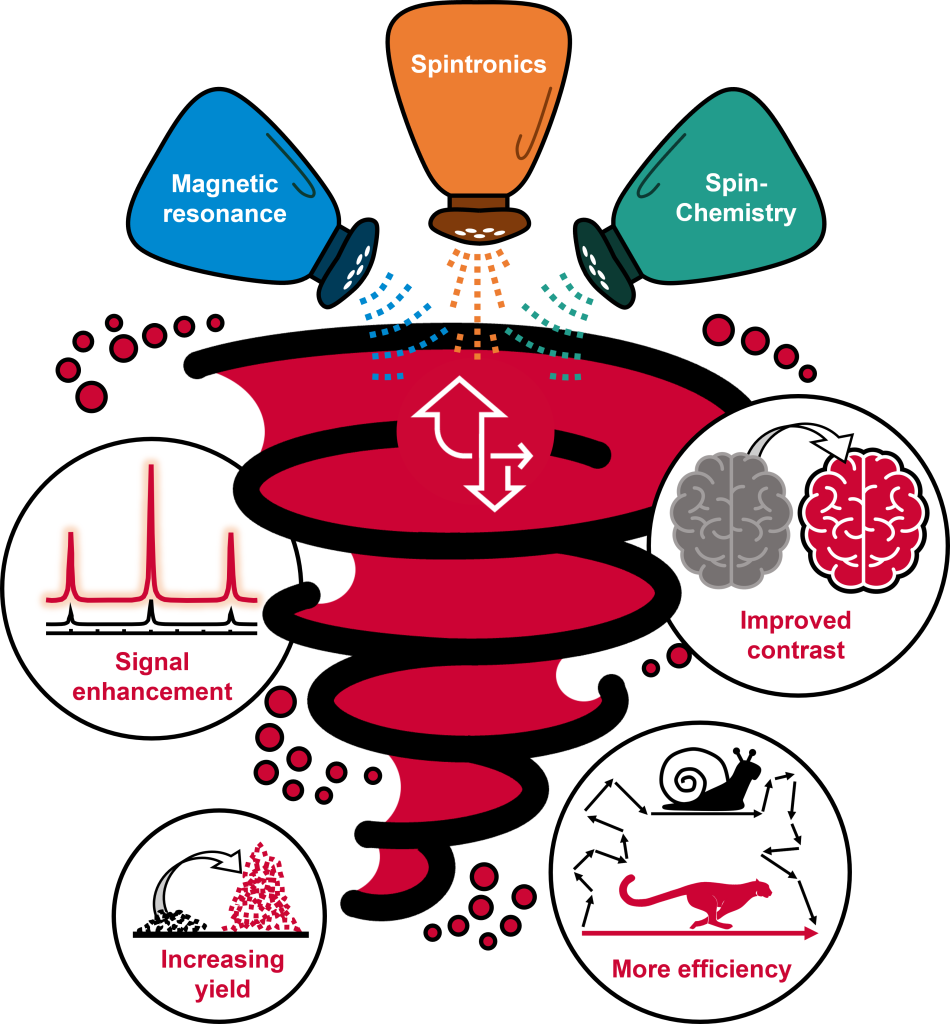Hyperpolarization in molecular systems
Polarization | Transport | Reactivity
Interested in a Doctoral position?
HYP*MOL is a German research network on hyperpolarization in molecular systems. It has been approved as a Collaborative Research Center (Sonderforschungsbereich)/Transregio by the German Research Foundation (Deutsche Forschungsgesellschaft, DFG) in May 2023 and started on 1 October 2023.
Electrons and many atomic nuclei carry not only electric charge, but also a magnetic moment called “spin”. The controlled realization of a transient spin order of electrons or magnetic nuclei, i.e., of hyperpolarization, in molecular systems is expected to have a major impact in three research areas of chemistry and physics, namely magnetic resonance, spintronics and spin-chemistry with implications towards practical applications for example in medicine, multifunctional electronics, or high-yield catalysis.
The TRR HYP*MOL will contribute to the fundamental understanding of generation of electronic and nuclear spin hyperpolarization, its transport through molecular structures and its control.

Summary presentation of our approaches and goals.
To that end, HYP*MOL will bring the fields of magnetic resonance, spintronics and spin-chemistry together. In all three areas, magnetic resonance, spintronics, and spin-chemistry, hyperpolarization will be deployed to enhance efficiency. We will focus on molecular systems, starting with small molecules, moving to oligomers and proteins, and finally to organometallic and covalent-organic frameworks (MOFs and COFs).
We aim to achieve rationally designed of molecular systems for hyperpolarization and along with this the development of hyperpolarization-based methods for structure, imaging, sensorics.
The research goals of the CRC HYP*MOL, organized into four joint work packages (JWP), will allow to:
(i) bring photo-CIDNP µ-MRI (photochemically induced dynamic nuclear polarization micro-magnetic resonance imaging) to biomedical applications (JWP1);
(ii) increase the understanding of spin transport mechanisms in molecular systems and unlock the CISS effect as a new source of hyperpolarization (JWP2);
(iii) improve the signal in dynamic nuclear polarization (DNP) establish DNP-based distance measuring for biomolecular structure determination (JWP3), and
(iv) optimize the production and transfer of hyperpolarization & achieve hyperpolarization on demand to small guest molecules for magnetic imaging or photocatalytic applications in MOFs and COFs (JWP4).
The fields of magnetic resonance, spintronics, and spin-chemistry will profit from the concerted approach of the CRC: (i) magnetic resonance will obtain new methods to produce hyperpolarization: Fundamental studies in spintronics will make the chiral-induced spin selectivity (CISS) effect available, and spin-chemistry will offer hyperpolarization via singlet fission; (ii) spintronics will profit from magnetic resonance by experiments and relaxation theory, and will receive from spin-chemistry knowhow on efficient interconversion of spin multiplicities as well as on the role of hyperfine interactions; (iii) spin-chemistry will extend its theory with concepts from magnetic resonance and spintronics to include spin-orbit coupling and spin dynamics in solid and soft matter.
All projects are carried out by interdisciplinary teams consisting of two to three group leaders combining experts in synthesis, analytics, and theory. Our integrated research training group (iRTG) will train the young researchers the benefits of looking beyond the horizon of single research field and making use of concepts from the three communities.
HYP*MOL builds on an excellent research infrastructure at both locations in Leipzig and Chemnitz and integrates leaders in the field strategically at additional partner universities. Our consortium develops up-to-date regional interdisciplinary information technology networks. We place particular emphasis on gender equality issues and on improving work-family balance.